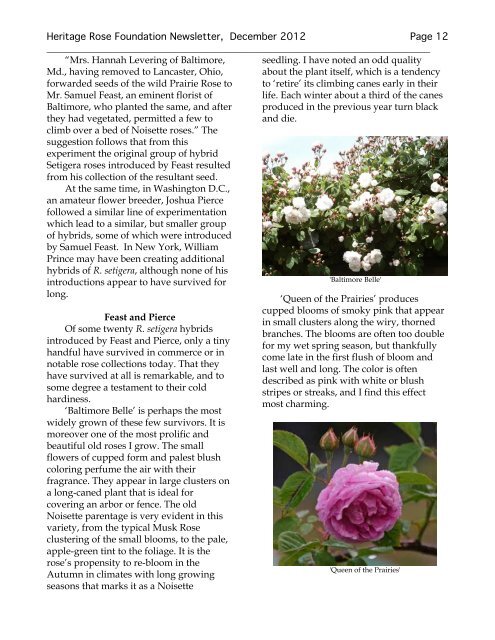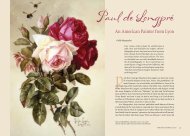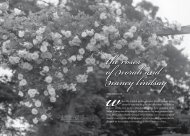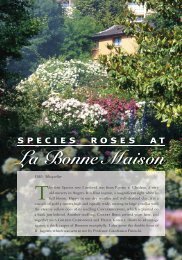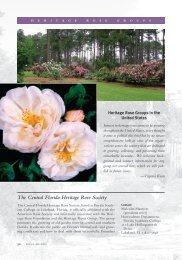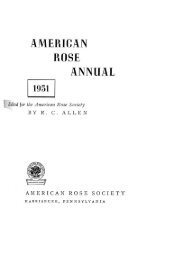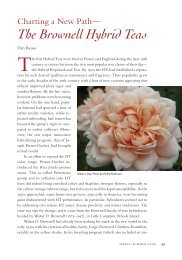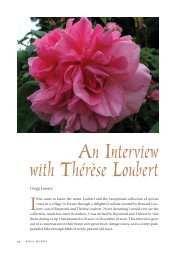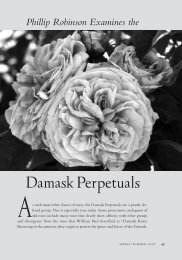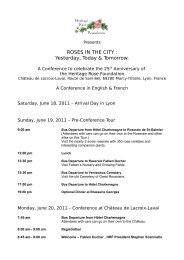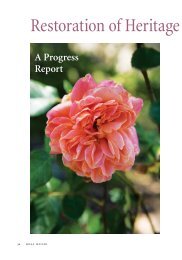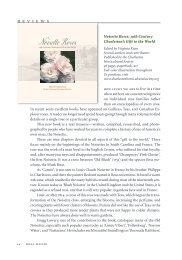Newsletter - Heritage Rose Foundation
Newsletter - Heritage Rose Foundation
Newsletter - Heritage Rose Foundation
You also want an ePaper? Increase the reach of your titles
YUMPU automatically turns print PDFs into web optimized ePapers that Google loves.
<strong>Heritage</strong> <strong>Rose</strong> <strong>Foundation</strong> <strong>Newsletter</strong>, December 2012 Page 12<br />
_______________________________________________________________________________<br />
“Mrs. Hannah Levering of Baltimore, seedling. I have noted an odd quality<br />
Md., having removed to Lancaster, Ohio, about the plant itself, which is a tendency<br />
forwarded seeds of the wild Prairie <strong>Rose</strong> to to ‘retire’ its climbing canes early in their<br />
Mr. Samuel Feast, an eminent florist of<br />
life. Each winter about a third of the canes<br />
Baltimore, who planted the same, and after produced in the previous year turn black<br />
they had vegetated, permitted a few to<br />
and die.<br />
climb over a bed of Noisette roses.” The<br />
suggestion follows that from this<br />
experiment the original group of hybrid<br />
Setigera roses introduced by Feast resulted<br />
from his collection of the resultant seed.<br />
At the same time, in Washington D.C.,<br />
an amateur flower breeder, Joshua Pierce<br />
followed a similar line of experimentation<br />
which lead to a similar, but smaller group<br />
of hybrids, some of which were introduced<br />
by Samuel Feast. In New York, William<br />
Prince may have been creating additional<br />
hybrids of R. setigera, although none of his<br />
introductions appear to have survived for<br />
'Baltimore Belle'<br />
long.<br />
‘Queen of the Prairies’ produces<br />
cupped blooms of smoky pink that appear<br />
Feast and Pierce<br />
in small clusters along the wiry, thorned<br />
Of some twenty R. setigera hybrids<br />
branches. The blooms are often too double<br />
introduced by Feast and Pierce, only a tiny<br />
for my wet spring season, but thankfully<br />
handful have survived in commerce or in<br />
come late in the first flush of bloom and<br />
notable rose collections today. That they<br />
last well and long. The color is often<br />
have survived at all is remarkable, and to<br />
described as pink with white or blush<br />
some degree a testament to their cold<br />
stripes or streaks, and I find this effect<br />
hardiness.<br />
most charming.<br />
‘Baltimore Belle’ is perhaps the most<br />
widely grown of these few survivors. It is<br />
moreover one of the most prolific and<br />
beautiful old roses I grow. The small<br />
flowers of cupped form and palest blush<br />
coloring perfume the air with their<br />
fragrance. They appear in large clusters on<br />
a long-caned plant that is ideal for<br />
covering an arbor or fence. The old<br />
Noisette parentage is very evident in this<br />
variety, from the typical Musk <strong>Rose</strong><br />
clustering of the small blooms, to the pale,<br />
apple-green tint to the foliage. It is the<br />
rose’s propensity to re-bloom in the<br />
'Queen of the Prairies'<br />
Autumn in climates with long growing<br />
seasons that marks it as a Noisette


